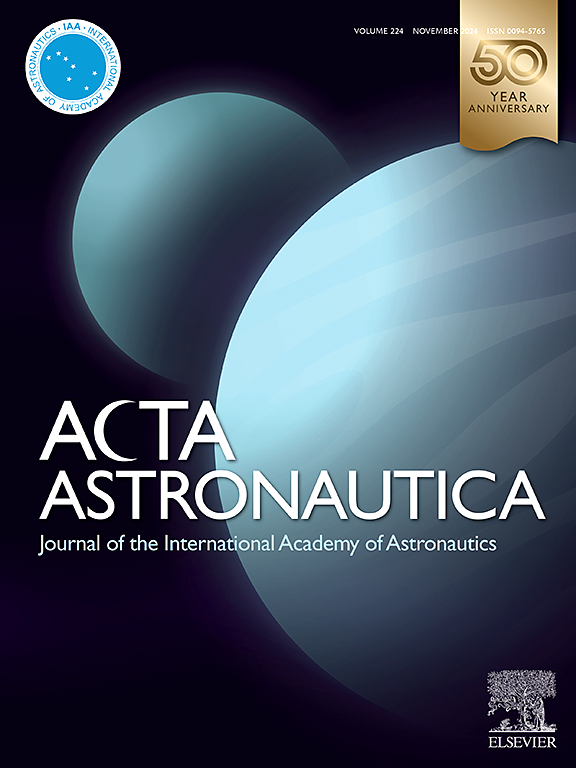低推力欠驱动卫星编队制导与控制策略
IF 3.1
2区 物理与天体物理
Q1 ENGINEERING, AEROSPACE
引用次数: 0
摘要
研究了近距离多卫星编队再配置的自主制导与控制策略。该编队由N个欠驱动副卫星和一个不受控制的虚拟或物理主航天器组成。每个副推进器都配备了一个可节流但无平衡的低推力喷嘴,需要推力和海岸弧的结合,在后者的姿态调整过程中,喷嘴将重新定向到所需的推力方向。制导问题被表述为结合动力学和物理约束的轨迹优化任务,以及典型电动推进器施加的最小加速度阈值。考虑了两种框架:集中式和分布式。集中式方法确保了燃料优化解决方案,但只适用于小地层,所有计算都在物理主卫星上进行。分布式方法虽然不是最优的,但通过将酋长视为虚拟点群并允许每个副手处理自己的计算,可以更好地扩展。研究了星载闭环控制的实现,保证了最优控制问题的可靠性和自动化。为了减轻不可行性风险,需要识别和软化构成潜在威胁的约束。实现了两种模型预测控制体系结构,即收缩地平线和固定地平线,并在燃油消耗和控制精度方面进行了比较。分析了它们在地球观测任务中所需的典型近距离重构中的性能,并对文献中现有方法进行了基准测试。本文章由计算机程序翻译,如有差异,请以英文原文为准。
Low-thrust under-actuated satellite formation guidance and control strategies
This study presents autonomous guidance and control strategies for reconfiguring close-range multi-satellite formations. The formation consists of under-actuated deputy satellites and an uncontrolled virtual or physical chief spacecraft. Each deputy is equipped with a single throttleable but ungimbaled low-thrust nozzle, requiring a combination of thrust and coast arcs, during the latter attitude adjustments redirect the nozzle to the desired thrust direction. The guidance problem is formulated as a trajectory optimization task incorporating dynamical and physical constraints, along with a minimum acceleration threshold imposed by typical electric thrusters. Two frameworks are considered: centralized and distributed. The centralized approach ensures fuel-optimal solutions but is feasible only for small formations, with all calculations performed on a physical chief satellite. The distributed approach, while sub-optimal, scales better by treating the chief as a virtual point mass and allowing each deputy to handle its own computations. This study focuses on spaceborne closed-loop control implementation, ensuring reliability and automation in solving the optimal control problem. To mitigate infeasibility risks, constraints that pose potential threats are identified and softened. Two Model Predictive Control architectures, shrinking-horizon and fixed-horizon, are implemented and compared in terms of fuel consumption and control accuracy. Their performance is analyzed for typical close-range reconfigurations required in Earth observation missions and benchmarked against existing approaches in the literature.
求助全文
通过发布文献求助,成功后即可免费获取论文全文。
去求助
来源期刊

Acta Astronautica
工程技术-工程:宇航
CiteScore
7.20
自引率
22.90%
发文量
599
审稿时长
53 days
期刊介绍:
Acta Astronautica is sponsored by the International Academy of Astronautics. Content is based on original contributions in all fields of basic, engineering, life and social space sciences and of space technology related to:
The peaceful scientific exploration of space,
Its exploitation for human welfare and progress,
Conception, design, development and operation of space-borne and Earth-based systems,
In addition to regular issues, the journal publishes selected proceedings of the annual International Astronautical Congress (IAC), transactions of the IAA and special issues on topics of current interest, such as microgravity, space station technology, geostationary orbits, and space economics. Other subject areas include satellite technology, space transportation and communications, space energy, power and propulsion, astrodynamics, extraterrestrial intelligence and Earth observations.
 求助内容:
求助内容: 应助结果提醒方式:
应助结果提醒方式:


